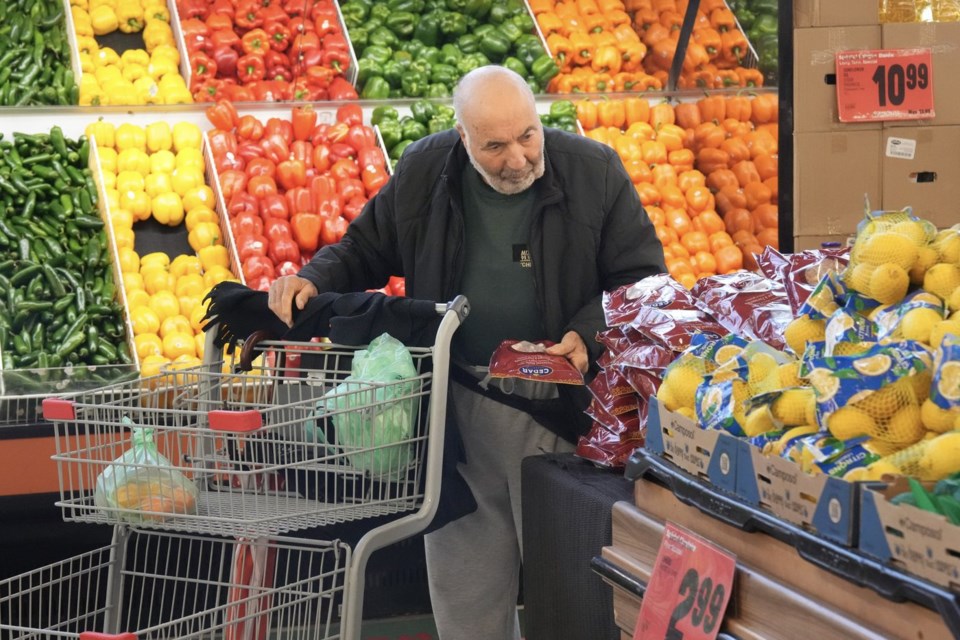It’s mid-December at a large supermarket in Mississauga, Ont., and Christmas music plays softly over the speakers as customers roam the aisles, picking the perfect lemon and eyeing the large olive counter in the middle of the store.
But this isn't just any grocery store. Walk past the produce and the olives, and you'll see trays of tabbouleh, hummus and fattoush, as well as shawarma cooking on rotating spits. Further, you’ll find a large dessert section with neat displays of golden baklava and other sweets. Behind two swinging doors, rows of puffed-up pita bread emerge on a conveyor belt from the oven, ready to be packaged and sold to customers.
This is Adonis, a Middle Eastern grocer that got its start in Montreal in 1978. The grocer is gearing up to open its 16th store, this one in London, Ont., next summer to meet demand from customers who often travel weekly to shop at the Mississauga location.
Specialty stores like Adonis are enjoying growth thanks to not only immigration but also the more diverse tastes of younger generations.
Regional director for Ontario Sherif El Gharbawy said Adonis is the “first stop once they land” for many newcomers to Canada — who often hear about the store before they even arrive.
“All the newcomers, this is where they start. Like this, you’re raising ... a new wave of loyal customers.”
Changing customer tastes are apparent in conventional stores too, where the so-called international aisle isn’t always enough to meet demand anymore.
“I think over the past 10 years (the grocers have) really done a good job in offering culturally diverse products,” said Salima Jivraj, account director and multicultural lead at Nourish Food Marketing.
Grocers have made big strides in expanding their offerings, said Jivraj — likely because they know how lucrative it can be.
“When it comes to advertising and marketing, multiculturalism is the mainstream now.”
Changing demographics — and tastes
The 2021 census catalogued more than 450 ethnic and cultural origins among the Canadian population. Statistics Canada says racialized groups are all experiencing growth — in 2021, South Asian, Chinese and Black people together made up more than 16 per cent of Canada’s population. Almost a million people identified themselves as Filipino, while 1.3 million identified as Indian and 1.7 million identified as Chinese.
Winning the shopping dollars of new Canadians is a key strategy for food retailers and producers, said Paul Hogan, vice-president and general manager at Conagra Brands International.
“You see that coming to life in store,” he said.
“There’s just a greater variety of offering and assortment, space allocation.”
But Canadians’ palates are changing for other reasons as well, Jivraj said, especially among younger generations.
“I think people in general ... they’re just more interested in different flavours from around the world, and they’re more adventurous with the food that they want to try.”
She attributes this in part to the restaurant scene.
“I think a lot of our inspiration of what we want to eat and what we aspire to eat comes from food service,” she said, adding that social media also plays a big role in introducing younger generations to different foods and recipes.
As grocers work to respond to changing customer demands, specialty stores like Adonis and Asian supermarket T&T are enjoying steady growth, as well as support from Canada’s largest grocers — T&T was purchased by Loblaw in 2009 and recently expanded into the U.S.
Metro bought a majority stake in Adonis in 2011 before buying the company outright in 2017. El Gharbawy said it was a sign that the big grocers were trying to attract a growing group of customers no longer seen as niche: “It’s something that everybody’s looking for.”
Adonis has added five stores to its network since 2017, said Adonis vice-president and general manager Eric Provost. He foresees more growth for the company, particularly in Ontario but also potentially in other provinces.
‘Channel blurring’
Like Adonis, T&T has seen its customer base broaden over time.
“We've grown beyond just an Asian clientele,” T&T chief executive Tina Lee told The Canadian Press in a recent interview.
Hogan calls this “channel blurring,” where retailers that have historically been associated with a specific community become popular across demographics.
That line is further blurred as private label products from specialty grocers make their way into other stores. On Loblaw’s recent earnings call, chief executive Per Bank said the company is bringing more T&T-branded products to its other stores to better cater to the growing immigrant population.
Some Adonis products can be found in other Metro-owned stores, said Provost, as well as products made by Adonis’ importer and producer arm Phoenicia Group.
Adonis stores vary a little depending on local demographics, said El Gharbawy, noting some stores' product mix might lean more Middle Eastern while other stores might cater more to Greek, Italian and Eastern European customers.
Grocers across the board have been paying more attention to the communities they’re in, said Hogan.
“They have data by neighbourhood, and so their offerings are getting more and more sophisticated and targeted to who their shopper is around them.”
This is the case for discount retailer Food Basics, which is also owned by Metro, showing how changing tastes are shaping different stores even within the same parent company.
As immigration has boosted Canada’s population over the years, meeting the demands of newcomers as well as other generations of immigrants has “just become that more important,” said Metro executive vice-president for Ontario Paul Bravi.
While in prior years some Food Basics stores didn’t even have an international aisle, the past decade has seen steady growth for the category, and now each store’s assortment caters to the local community, said Bravi.
“I think the next 10 years, though, it’s going to be an accelerated growth,” he said.
“It’s critical to our future.”
This report by The Canadian Press was first published Dec. 22, 2024.
Companies in this story: (TSX:MRU, TSX:L)
Rosa Saba, The Canadian Press




